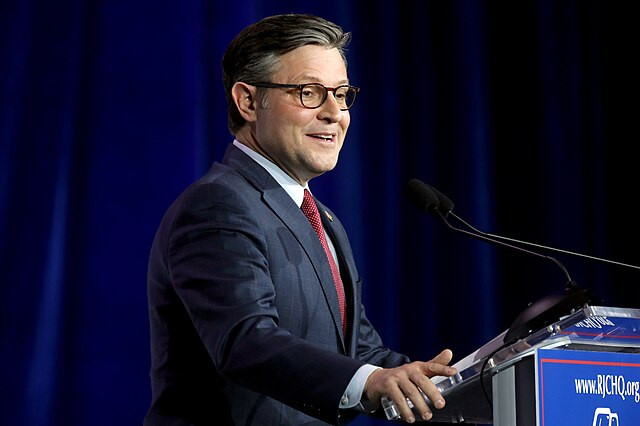House Speaker Mike Johnson secured a narrow but pivotal victory Tuesday night, advancing a critical budget blueprint that will serve as the foundation for President Donald Trump's legislative agenda. The 217-215 vote came after a last-minute push by GOP leaders, aided by direct outreach from Trump, flipping key Republican holdouts who initially resisted the measure.
Republican lawmakers had nearly abandoned the vote earlier in the evening when it became clear they lacked the necessary support. However, Johnson and his leadership team reversed course, summoning lawmakers back to the House floor and successfully securing the final votes. The turnaround stunned both opponents and supporters, marking a significant moment in the GOP's effort to implement Trump's sweeping policy proposals.
"The world didn't end today. But I do see the edge," said Rep. Pat Fallon (R., Texas), referring to the high-stakes battle over the budget framework.
The blueprint, a procedural step in the legislative process, lays the groundwork for a broader package that includes deep spending cuts, tax reductions, increased funding for border security and energy production, and a two-year debt ceiling increase. While the House version aligns with Trump's campaign promises, it differs from the Senate's version, which focuses solely on national security and energy funding, leaving key issues unresolved.
Intense Negotiations and GOP Divisions
Johnson faced significant resistance from both fiscal conservatives and centrist Republicans, who raised concerns about the plan's impact on entitlement programs such as Medicaid. Hardline conservatives argued that the proposed spending cuts were insufficient, while moderates worried about potential voter backlash if cuts to safety-net programs were enacted.
Rep. Thomas Massie (R., Ky.), the lone Republican to vote against the measure, remained steadfast in his opposition, saying he was unconvinced by leadership's arguments. "They convinced me in there, I'm a no," he said, holding up a thick packet of GOP talking points.
In contrast, Rep. Warren Davidson (R., Ohio) flipped to support the measure after receiving "assurances" about future efforts to cut discretionary spending. Rep. Victoria Spartz (R., Ind.) also changed her vote after a direct call with Trump, saying, "He's on board to get some great things done on health care. ... I trust his word."
Trump's Influence and the Path Forward
Trump's personal involvement played a crucial role in securing the final votes. As negotiations faltered, he reportedly called multiple lawmakers, urging them to support the bill and promising that his administration would prioritize key conservative policy goals.
Despite the late-night success, significant hurdles remain. The House and Senate must reconcile their competing budget plans before Trump's legislative package can move forward. Any misstep could threaten other priorities, including the GOP's efforts to avoid a government shutdown next month and address a potential debt crisis later this spring.
The House-passed blueprint sets up a legislative vehicle that would allow Republicans to pass key elements of Trump's economic agenda without Democratic votes. The framework includes:
- $4.5 trillion in tax cuts, primarily by extending and expanding Trump's 2017 tax cuts.
- $300 billion for defense and border security, a top priority for the White House.
- A $4 trillion debt ceiling increase, allowing the government to borrow through 2026.
- $2 trillion in mandatory spending cuts over the next decade, with reductions spread across multiple federal programs.
However, the plan could add nearly $3 trillion to the deficit over 10 years, an issue that has divided Republicans and drawn criticism from Democrats.
Medicaid, Entitlement Cuts and Political Risks
One of the most contentious elements of the budget plan is the potential impact on Medicaid and other entitlement programs. Since Trump has ruled out cuts to Medicare and Social Security, critics argue that the $880 billion in proposed savings from the Energy and Commerce Committee will inevitably fall on Medicaid.
House Budget Committee Chairman Jodey Arrington (R., Texas) defended the plan, saying, "It doesn't add to the deficit because if we don't believe that our pro-growth, pro-work, pro-energy policies will generate enough macroeconomic feedback and revenue to the Treasury to grow this economy... then we just don't have enough faith in our own policies."
House Majority Whip Tom Emmer (R., Minn.) dismissed concerns about entitlement cuts, emphasizing that the blueprint does not mandate specific policy changes. "This is a procedural vote. You tell me what the cuts are," he said when pressed on Medicaid reductions.
However, several moderate Republicans from swing districts remain uneasy. Rep. Mike Lawler (R., N.Y.) sought reassurances that final legislation would not include Medicaid cuts, stating, "The president's been very clear, he doesn't want to cut Medicaid, and I've been very clear."
Next Steps and Political Fallout
The House GOP's success in passing the budget blueprint marks a crucial step in Trump's effort to implement his economic agenda. However, the fight is far from over.
Republicans will need near-unanimous support in both chambers to pass the final legislative package. Meanwhile, Democrats are expected to use the budget fight as a rallying cry ahead of the 2026 midterm elections, portraying the GOP's proposals as a "betrayal of the middle class."






